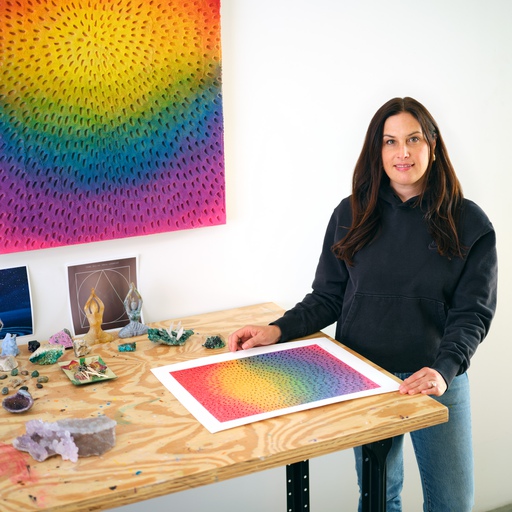Chuck Webster's small, power-packed paintings are somehow bigger than their size would suggest, drawing the viewer into their enigmatic worlds with an irresistible gravitational force. Abstract compositions that seem to exist in their own dimension, these works conjure dreamlike associations—one might look a little like a castle, another like a submarine or a heraldic shield—through shapes that the artist harvests from a dizzying range of sources, everything from early Renaissance painting to gang tattoos and video games.
Born in Binghampton, New York, in 1970, Webster has developed a following among curators, seeing his work included in surveys of cutting-edge painting at MoMA PS1 and at the San Diego Museum of Art. In 2009 the curator and art critic Bob Nickas featured him in Painting Abstraction, an influential book surveying the vanguard of contemporary abstract painting; Webster's passion for creating works on paper was also spotlighted in the 2001 documentary film Chuck Makes a Woodcut. The artist is also beginning to get wider recognition as well: New York Times critic Roberta Smith hailed his recent show at ZieherSmith Gallery as "the best of his career," and British megacollector and no less than star-maker Charles Saatchi snatched up four paintings.
To learn more about Webster's art, we spoke to him about the diverse sources of his inspiration and his creative process.
Click here to watch a video of our studio visit with Chuck Webster.
How do you begin your paintings?
First I just start drawing, or making marks, and then I invent a narrative from where the marks take me. There are all kinds of things that can happen. I can start doing one thing and it looks like a face, but then I'll do another thing and it changes the narrative. Then I expand the drawing into a painting, and altering the scale of the marks or working with different materials, like spray paint or oil, can change the narrative again. How big the mark is, if it's body-scale or small-scale, makes you relate to it differently—body-scale shapes can look like a building, for instance, or a person. So I make my paintings based on this impulse, and then I keep going, following the associations that crop up. What I've been doing for the past six or seven years was making thing that were sitting in the middle of the painting, declaring themselves to be iconic. Now I'm reaching into the sides of the panel and getting back to making something where the picture plane stretches off of the canvas. In earlier work I created a kind of landscape in the picture plane for the shapes to exist. Now I'm using more of the picture plane as abstract painting ideas about creating an icon.
It seems like a form of dream logic in a way, in that you're following different stream-of-consciousness pathways. What kind of associations guide the abstract shapes in your work?
Dream logic is marvelous—that's true. There are all kinds of associations that come from things I study, from gang tattoos to 14th-century icons by Giotto. It's automatic. But I carry around a lot of things in terms of shape memory, and that probably has come from looking at things like Sacred and Profane Love by Titian and drawing it and seeing how the painting works. Studying Giotto, especially. It's just some the most direct and profound artwork made in the last thousand years. And I don't mean in any way to insanely say that I'm anything like Giotto, but his shapes have lodged themselves in my memory. I like to look at Renaissance the most, like Piero della Francesca. These are paintings that never seem to have been painted—that seem to have just appeared—and I relate that to books like The Gift by Lewis Hyde, where he says that you're a vessel for the inspiration that comes through you, and that making art is the purest act of freedom possible. In my drawings I go to this plane where they just come through me and come out of the exchange of energy between me and my environment. It's very profound.
You mentioned narrative. How does that figure into your abstract paintings?
It comes in organically, I think. A perfect example is this drawing I was making where I was working away and suddenly there were these two shapes that could be people, but they also looked like eyes, so that narrative appeared instantly and I called it Sleeper because it looked like someone sleeping.
Of course, the average viewer might not have the same associations that you do, so they're free to read in their own interpretations and stories too.
Yeah, you can jump in and out of any narrative. The idea of being multiple things at once is what's called a "double activity," where your thoughts and your actions happen simultaneously but work in several directions. For example, I'll intend to make something that looks like a tank and then the idea of a pineapple will go through my mind and I'll follow that. So the paintings are in a flux state, existing between different narratives. And after a recent show someone told me that he felt you could climb into my paintings, and I thought that was a great compliment. It's like you're in a video game—you imagine yourself to be like Mario, bouncing along.
Some of your earlier paintings work a bit like Rothkos, where you look at it and there seems to be a certain kind of spatial relationship between the shapes but then you look at it again and suddenly a completely different relationship emerges. Now you seem to be creating a much clearer and more readable sense of space in your paintings.
Yeah, I'm working with body-scale as a big idea now, and also architecture, with interiors and exteriors, and the idea that a tree is something outside that you can climb but it's also the shape of blood vessels that are inside of you. The new paintings are also much faster—they're made quickly, which comes from wanting to have the same degree of freedom that I have in my drawings. I wanted them to show my hand more too.
How do you know when a painting at last comes together, when it's finished?
There are all kinds of ways. You'll do twenty different things to it and then the painting will say, "Ugh, I'm just a painting, leave me alone!" There's also a case where it finishes itself, where you don't work on it for several months and it's just sitting there and you say, "Ok, fine. You're done."
How does color work in your compositions?
Color for me is completely intuitive and natural. I use color straight out of the tube and I tend to use a lot of red, which is weird, so sometimes I'll have to go and use green or brown or green or purple because I need to get away from red.
What role do titles play in your paintings?
Well, I didn't title any of my paintings in my last show because I wanted to relate to them in a way that is closer to the way I relate to my drawings. I find it to be a weird notion that the creative impulse is judged on one level when you're sitting with friends and doodling and there's something exchanged between you and the material and then on another level when you're alone in the studio working on a large panel or canvas, which is supposed to be a different thing. I wanted to shorten the distance between those two situations, so I didn't title the paintings because I don't title any of my drawings. But I love titles, because I think about a lot of different things when I'm working, like songs, cartoons, poetry, literature, and music. I think of Guided by Voices lyrics as being great titles, like "remain on watch," which is from their song "Buzzards and Dreadful Crows."
You've said before that you can remember all of the lyrics to Guided by Voices songs, which is interesting because those songs seem to be a perfect analogy for your work—they're low-fi, self-contained, and a little offbeat while at the same time being exquisitely wrought.
Yeah, and they're done very, very quickly. He just composes weird little songs in his notebooks that he sings. And there's one with the line "when the lake of worry consumes you, do you feel unwanted," which just contains so much emotion and internal angst and narrative that's pushed quickly into this very small place. It's a way of dealing with the world and dealing with what happens, and it's so low-fi. There's a bootleg recording where he says, "This is what we taught the world: that you can suck and still be good," and I just think that's amazing. It's also a little like Louis C.K.'s stand-up, which I've been watching a lot of recently.
What kind of art are you looking at these days?
I like to look at everything. I'm looking at Gorky a lot now, I love Malevich and Picabia. And I have a box full of postcards from all over the place that I look at too. Like Agony in the Garden by Giovanni Bellini, which is one of my favorite paintings, and pictures from the Victoria & Albert Museum and the Elgin Marbles from the British Museum. I carry a lot of these images of artworks, as well as movies and video games, in my mind.
What do you hope viewers get out of your paintings?
Pleasure. Entertainment. Laughter. But I want my work to be funny and also profound in a way—something that people can get enjoyment out of. I love the idea of that there's an organization called RxArt that puts art in hospitals. I think that would be a great honor, to have a painting in a hospital where someone who is sick can go and look at it and feel better and go on some kind of internal journey. I want my paintings to give. Creating art is something I have to do—I have to make these things, and I try to make them better all the time. But I also want them to exist in the world in a beneficial way.
Artist to WatchChuck Webster
























